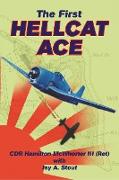- Start
- The First Hellcat Ace
The First Hellcat Ace
Angebote / Angebote:
THE FIRST HELLCAT ACE
Cdr Hamilton McWhorter, III, USN (Ret)
with Jay A. Stout
Though he objected to being called such, Hamilton McWhorter III's service to family and country make him a standout among America's Greatest Generation. A Georgia native whose family roots date from that region's settlement during the 1700s, Mac McWhorter was a naval aviation cadet undergoing training when Pearl Harbor was attacked on December 7, 1941.
After earning his Wings of Gold in early 1942, Ensign McWhorter was trained as a fighter pilot in the robust but technologically outmoded F4F Wildcat. Initially assigned to VF-9-a fiercely spirited and hard-playing fighter squadron-he saw first combat in November 1942 against Vichy French forces in North Africa.
After returning to the United States, VF-9 became the first unit to convert to the new Grumman F6F Hellcat fighter-the fighter the U.S. Navy would use to crush Japanese air power during the long offensive from the Southwest Pacific to the shores of Japan.
From mid 1943, Hamilton McWhorter was constantly engaged in the unforgiving and deadly aerial warfare that characterized the battles against Imperial Japan. His fifth aerial victory, in November 1943 off Tarawa Atoll, made him the first ace in the Hellcat, and seven subsequent victories ensured his place in the annals of air-to-air combat. McWhorter's combat service, from the beginning of the war to the last campaign off the shores of Okinawa, makes his story a must-read for the serious student of the Pacific air war.
Hamilton McWhorter III retired from the Navy as a commander in 1969. He passed away in 2008.
A Marine F/A-18 pilot from 1981 to early 2000, Lieutenant Colonel Jay A. Stout is a combat veteran with over 4, 600 flight hours. He has also authored Hornets over Kuwait, which recounts his own experiences during the Gulf War.
What the experts are saying about The First Hellcat Ace:
"Mac McWhorter not only survived three carrier deployments in World War II, he earned a reputation as one of the Navy's deadliest fighter pilots. His memoir captures the attitude of his generation-the heroism and the sacrifice, and the return to a loving famiy. It was an era never to return again." --Barrett Tillman, author of Hellcat: The F6F in World War II
"Mac McWhorter became a noted Navy fighter ace during World War II, his three carrier deployments characterized by intense combat, the loss of numerous squadron mates, and the pain of separation from his wife and family. His memoir is not the stuff of legends or glamour so often associated with fighter pilots, but a sensitive look at the realities faced by carrier aviators who go in harm's way." --Bruce Gamble, author of Black Sheep One: The Life of Gregory "Pappy" Boyington
"Not only a thrilling account of some of the great air battles of the Pacific war, Hamilton McWhorter's book provides a window through which we can view a generation of young men at war, impressed by their camaraderie and spirit and humbled by the hardships and fears they overcame." --M. Hill Goodspeed, historian at the U.S. Navy Aviation Museum
"Today the U.S. Navy's World War II fighter pilots remain less well known than their Army Air Forces counterparts. One reason is that they have left far fewer memoirs, a great loss, because nothing can replace authentic descriptions of fighter combat by those who actually did it. Fighter ace Hamilton "One Slug" McWhorter, a member of elite Fighting Squadron 9, flew nearly the whole war, first over Northwest Africa, then in the 1943-44 Central Pacific offensives, and finally in the grim assaults against Iwo Jima and Okinawa, and in the skies over the Japanese homeland. Vividly written, The First Hellcat Ace is an important contribution not only for the Pacific but the air war in general." --John Lundstrom, author of The First Team: Pacific Naval Air Combat from Pearl Harbor to Mi
Folgt in ca. 15 Arbeitstagen
